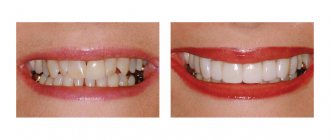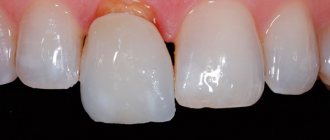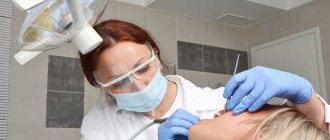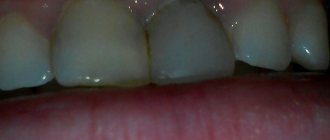A tooth on an artificial root has a multicomponent structure. The supporting part in the form of a cylindrical or conical rod sits tightly in the jaw bone. An abutment imitating a tooth stump is fixed on top of the root substitute. And the prosthesis is already attached to it. Normally, all elements of the system are fixedly connected to each other, so if the crown on the implant is loose, it needs to be sorted out. There may be several reasons for this phenomenon, which is the task of the dentist to establish.
What symptoms accompany implant mobility?
There are two possible scenarios:
- there is no inflammation of the tissue around the implant, and it just wobbles, but does not hurt,
- the implant wobbles due to inflammation and pain in the jaw.
Of the possible complications, the first “scenario” is the least dangerous condition, which is most often caused by errors of the specialist installing the structure, and a number of diseases that affect the rate of osseointegration (diabetes mellitus, for example). In this case, the patient simply feels the mobility of the metal rod 2–3 weeks after the operation, the implant wobbles a little. The soft tissues around retain their former natural appearance, there is no pain or change in condition in the oral cavity. This is the most favorable outcome, allowing you to correct the situation with the least damage to your health and wallet.
However, the implant can also wobble due to poor-quality installation, as well as complete failure to engraft into the bone. This situation is not favorable - most likely, the product will have to be removed.
In the second case, mobility against the background of inflammation is a serious symptom that indicates rejection of the structure. And the instability of the structure, as a rule, occurs after the long-term existence of other signs of inflammation:
- the gums around the implant have changed color, become bright red, bluish, unevenly colored,
- there was slight swelling,
- the mucous membrane does not adhere tightly to the artificial structure, partially detaches from its surface,
- when chewing, pain occurs, as well as when touching the gums,
- bleeding gums around the implant,
- the appearance of a putrid odor from the area of the installed implant,
- discharge of pus from under the gums,
- body temperature remains elevated to 39°,
- there is a general malaise.
All these symptoms indicate developing mucositis or peri-implantitis - first superficial, and later deep inflammation of soft and bone tissues.
In both cases, you should not wait for the situation to improve; you should immediately seek professional help. Read more about the unfavorable outcome of implantation in the material “Dental implant rejection.”
Signs of rejection
On average, the implant takes about 3 months to take root on the mobile jaw and 6 months on the upper arch. This discrepancy in timing is due to the fact that the lower jaw bone receives better blood, it is generally larger and denser, and the strongest chewing pressure is exerted on it.
In addition, a large air sinus is visible above the upper jaw bone, the close location of which in most cases creates additional difficulties in the implantation process.
Osseointegration is the phase of fusion of a metal product with the soft and hard tissues of the jaw, which is activated immediately after installation manipulations.
The duration of the engraftment period largely depends on the initial state of the dentofacial apparatus, as well as on the quality and model of the artificial root itself.
Moreover, it does not matter which implantation technique was chosen. That is, it does not matter whether the implant is loaded immediately (simultaneous implantation) or after complete engraftment with tissues - in both the first and second cases, the period of osseointegration has almost the same duration.
According to statistical data, rejection of the dental root analogue most often occurs in the first days after it is screwed into the bone. If complications or unforeseen troubles occur, the first symptoms usually appear quickly.
However, you should not lose your vigilance. Even successful implantation of the system cannot completely eliminate the possibility of rejection. Pathological changes can occur even after several years of active use of a new tooth.
The main signs that the design is not ideal:
- the appearance of painful sensations a week after installation (the norm is 3 days of painful discomfort);
- prolonged swelling of the gum tissue (with inflammation, swelling persists for more than 5 days);
- sharp pain when pressing , accompanied by pulsation (this symptom is pronounced in the case of replacing a chewing tooth with an implant, since it is these organs that take on the load more than others during meals);
- unsteadiness of the structure (proper fixation of the implant and crown prevents displacement, and if the position of the elements has changed, then a problem has arisen that requires immediate correction);
- bleeding of the wound site for more than 7 days;
- daily metallic taste in the mouth;
- redness of the gum tissue in the implantation area;
- general weakness of the body , which cannot be justified by another reason;
- the appearance of purulent exudate from the wound;
- unpleasant odor emanating from the wound area (a clear sign of an inflammatory process).
Remember! If the position of the structure is broken, it is important to immediately seek help from a specialist. It is very unwise to delay emergency treatment.
This can lead to destructive processes in bone tissue and complete destabilization of the system, up to its loss.
When it is not the implant that is loose, but the crown on it
How to determine whether an implant or crown is loose? The entire structure, which completely replaces the tooth, consists of several elements - an artificial root, an abutment and a crown that replicates the outer visible part of the tooth. Depending on the type of structure and the method of fastening the crown, the connection of the parts to each other may be different.
Read more about fixing crowns to an implant in the material “How to choose a crown for an implant and which ones are better? Review of modern single prostheses and methods of their fastening.”
It is possible that the screw fastening between the crown and the abutment may loosen or the properties of the cement composition may be lost for a number of reasons. But the implant itself can also become loose. However, at home it is difficult to reliably determine which element has weakened the fixation; this requires assessment and diagnosis by a specialist.
If it turns out that the crown is indeed weakened, then you can return it to its place in the clinic where the implantation was performed. Such cases occur more often with temporary crowns. The doctor will tighten the screw with a special tool and secure it to the implant. When the elements are cemented together, the crown “sits” again after cleaning.
How to remove a movable prosthesis, and what will happen to it next
What does a dentist do when a bridge becomes loose? Here, further treatment tactics can be “suggested” by an x-ray examination. But, as a rule, the bridge has to be removed. Removal is carried out using an ultrasonic scaler (which crumbles the cement inside). Crown and bridge removers are also used - for example, a Kopp apparatus or an automatic micromotor Anthogyr Safe Relax with strings (cables) and hooks. Once the deficiencies are corrected, the old prosthesis can be fixed back in place.
If it is impossible to remove the bridge without damage, the doctor will use special scissors or crown-cutting forceps - after which a new prosthesis will need to be made.
What causes implant loosening - the main reasons
If a tooth implant begins to wobble, then the reasons for this must be sought in one of three directions. Among them:
- physician errors: rejection due to specialist errors is noted at the initial stage of implantation of the structure (in the first 3–4 weeks) and indicates a poorly performed operation. We will look at possible errors in more detail below.
- systemic diseases and conditions of the patient: they affect the rate of osseointegration or affect the implant that has already taken root. If the cause is disease (periodontitis, hormonal changes during menopause or menstruation in women), then part of the reason for rejection can be considered the shortcomings of the preparatory period on the part of the doctor, who did not take their presence into account. Also, a patient can hide his illnesses from the doctor and, at his own peril and risk, decide to have an operation, the result of which will be rejection. Mobility may occur 5 years or more after implantation due to the appearance or development of systemic diseases, the occurrence of which is difficult to predict,
- patient errors: they are mainly related to the care of installed structures and prevention. By maintaining a level of hygiene for implants and prostheses, the patient creates conditions for their long-term service. Ignoring the requirements can also lead to such unpleasant consequences as inflammation of the tissues around the implants, which, as it progresses, leads first to mobility and then to rejection of the structure.
We must not forget that we are considering exceptional cases of implant mobility and rejection. In general, clinical practice and statistics[1] indicate 2–5% of such cases.
Reviews
According to statistics, with high-quality implantation and prosthetics, the crown should not wobble. Especially if before the operation the doctor collected the patient’s medical history, paid attention to contraindications and assessed the condition of the jaw bone. High-quality implantation means successful osseointegration.
To the least extent, the movement of the prosthesis depends on the material used in its manufacture. According to patient reviews, the problem most often arises due to incorrect orthopedic work, when a specialist overestimates the crown, which cannot ensure reliable fixation. In any case, if pathology occurs, it is important to consult a doctor without delay. Only he can correctly determine the reasons for what is happening.
If you have already encountered such difficulties after implantation and successfully eliminated them, share your experience with the readers in the comments to this article.
If you find an error, please select a piece of text and press Ctrl+Enter.
Tags crowns fixed dentures
Did you like the article? stay tuned
No comments yet
Implant mobility caused by erroneous actions of the doctor
If the implant begins to wobble during the healing period, for example, a month after installation, then the problem most often lies in the incorrect actions of the doctor while preparing the patient for implantation and directly during the installation operation. Since implantation is a complex undertaking, the doctor may make mistakes at different stages, both at the beginning and directly during the surgical intervention.
During preparation
Receiving false information about the condition of the bone where implants will be implanted. This is possible with insufficient and uninformative diagnosis, when other methods are used instead of computed tomography - orthopantomogram (OPTG) or radiography.
Incomplete preliminary examination (or complete refusal of it) of the patient to determine if he has relative and absolute contraindications that make implantation difficult or impossible. It is also possible that the doctor will not take into account the special hormonal status of women (menopause, postpartum or menstrual period) and will allow surgery during this period without taking into account the condition.
During the preparation of the treatment plan
Incorrect assessment of the place for the implant in the bone, the location of the artificial structure is too close to the roots of living teeth, with insufficient bone tissue.
Directly during surgery
There is a wide scope for incorrect actions: violation of the sterility of instruments and equipment, bacteria entering the prepared hole along with saliva, or when the edge of the implant touches any surface. The use of improperly sized implants, the use of structures for a different surgical protocol, overheating of the bone tissue when forming a bed for the implant, installation of the rod at the wrong angle, excessive deepening of the rod, etc.
For prosthetics
During the manufacture of the prosthesis, violations may occur, resulting in incorrect distribution of the chewing load, inconsistency of the prosthesis with the implants, penetration of the cement composition into the socket, prosthetics of only one row without taking into account the load on the second, and others.
In order not to encounter unpleasant consequences of implantation, a specialist must be chosen carefully, based on many indicators of his work. How not to make a mistake with your choice, read the material “How to choose a doctor and clinic?”
Prosthetics provided that the supports are intact
After the bridge is removed, the condition of the supporting teeth and gums is examined and, if necessary, treatment is carried out (carious tissue is removed, the canals are re-filled, a new pin or stump inlay is placed). Since the relief and dimensions of the support often change during the treatment process, impressions have to be taken again and a new bridge made.
The old bridge can be put back if, for example, the problem was low-quality or old cement - which will be removed from the product, and then the prosthesis will be fixed with fresh and high-quality adhesive. If the service life of the prosthesis has already come to an end and it has cracks, severe abrasions, or chips, a new one needs to be made.
Systemic diseases and body conditions affecting the fixation of implants
These include chronic diseases that make up the list of contraindications for implantation. They may go unnoticed or deliberately hidden by the patient, or appear much later, when the implant has been standing for several years.
Read about indications and contraindications for implantation in the feature article on the website “When you can or cannot place dental implants - a complete list of tolerances and prohibitions.”
Dental implant failure can occur due to the following diseases:
- diabetes mellitus in a long stage of decompensation,
- pathologies of the central nervous system,
- disruptions in the body's immune system,
- development of oncological tumors of any localization and subsequent therapy,
- allergic reactions in the oral cavity to the components of an implant or prosthesis,
- trauma of the maxillofacial apparatus,
- oral diseases
To avoid unexpected consequences of these diseases, experts recommend regular preventive oral examinations and monitoring of chronic diseases.
Prosthetics, if supports have to be removed
Very often, over years of increased stress, the supporting teeth are so destroyed that they have to be removed along with the roots. They can also collapse even after a few months or a couple of years - if there were any undetected diseases before prosthetics (this has already been discussed above). Or, if the patient did not see a doctor for a long time, he endured unsteadiness and pain. After removal, you will need to install either a longer bridge and “prepare” new supports for it, or a removable denture.
“I had a metal-ceramic bridge installed on my front teeth a couple of years ago, but then suddenly it began to wobble. At first I didn’t attach much importance to it. Maybe it seemed like a little. But he staggered more and more, and his tooth began to ache. I went to the dentist. The verdict is to remove the tooth, there is a large cyst. I don’t understand where it came from.”
Stanislav, review from otzovik.com
But the best option is implantation. This way, it will be possible to preserve the remaining living teeth (and not use them for supports) and extend the service life of the new orthopedic structure. After all, dentures on implants last approximately 2 times longer than those installed on natural teeth.
Read on the topic: dental bridge on implants - what it is and who it is suitable for.
The occurrence of implant mobility due to patient negligence
Here it mainly concerns oral hygiene and the rules of care for implants and prostheses installed on them. If the doctor performed the operation competently, taking into account all the patient’s characteristics, then the responsibility for the rehabilitation period falls 90% on the patient’s shoulders. If a dental implant wobbles due to gum inflammation, this indicates an extreme degree of peri-implantitis. Complications at this time and much later are possible for a number of reasons:
- refusal to take medications prescribed by a doctor to restore tissue, prevent inflammation, etc.,
- smoking and drinking alcohol after surgery, unwillingness to give up bad habits in the future. It is known that smokers experience implant rejection twice as often[2] (7% of cases) than those who are not exposed to the bad habit.
- insufficient daily care of dentures and implants, lack of proper hygiene, accumulation of bacterial plaque around implants,
- overload of implants when chewing too hard food, untimely (too early) load on the rods.
All this leads to the development of inflammation and, without treatment, to implant mobility and, ultimately, to rejection of the structure.
Read about the organization of comprehensive oral care after implantation in the thematic material on the website “Care for the oral cavity and dentures after implantation.”
Prevention measures
To prevent crown loosening, you must:
- Clean your teeth, gum tissue, tongue and dentures daily to remove bacterial plaque. To do this, you need to purchase special hygiene products, including a brush with gentle bristles.
- After eating, remove food particles from interdental spaces. Dental floss is ideal for this.
- Do not overload the implant system with excessive chewing pressure.
- Remove very hard and hard foods from your diet.
- Follow the schedule of preventive examinations (visits at least 4 times a year).
- Visit your doctor every six months for professional cleaning.
- Stop smoking, because... this harmful habit provokes bone loss.
- Regularly inspect the installation site of the prosthesis for damage and changes in the position of structural elements.
- Once every 6 months, take a control x-ray, which will help assess the condition of the bone and notice possible atrophy in time.
- Immediately after the operation, visit a hygienist to receive sanitary and hygienic recommendations and carry out an individual selection of cleansing, antibacterial and anti-inflammatory agents.
Treatment methods
If the gum former or crown is loose, the reason must be sought in a violation of the stability of the rod, among those described above.
Sometimes it is enough to tighten the implant and everything will be fine. In case of serious problems, the implant is removed and a course of antibacterial treatment is prescribed to eliminate inflammatory processes. After this, diagnostics are carried out aimed at finding out the cause of rejection.
Heal former
When the problem arose due to the fault of the doctor, the operation is repeated, taking into account the mistakes made. In place of the removed rod, a new support is placed, but with a larger diameter. In good clinics this is done free of charge.
If the structure is wobbly due to insufficient bone volume, augmentation is performed. Implants are not installed immediately after this. The waiting period depends on the characteristics of the body and the technique used. Recovery with block transplantation takes approximately 2 months, with open sinus lift - from 3 to 5 months.
The essence of bone grafting
If the cause of rejection has not been found, re-implantation of the rod will have to be abandoned. The same will have to be done if the structure has become loose due to deteriorating health. In such cases, the dentition can be restored using bridges or removable dentures.
When is it better to replace a bridge or crown?
If mobility of the entire bridge, some part of it, or a separate crown appears, then the best option for what to do next is to immediately contact an orthopedic dentist. Of course, the patient’s desire to keep the old prosthesis and continue to walk with it is understandable. But it is not always possible to save the orthopedic structure.
When should a crown or bridge be replaced? While a small chip of ceramics can be “repaired”, large chips or cracks are difficult to restore – so the doctor suggests a replacement. If 1-2 crowns fall off, if you are allergic to the material, you will have to make a replacement. You will also have to make a new prosthesis if the support was drilled, the stump tab or pin was changed, or if teeth were removed.
1Markskors R. Fixed dental restorations, 2007.
QUESTION ANSWER
QUESTION Tell me, if the bridge is wobbly on only one side, as if it moves a little when chewing, then what should I do to secure it? Anatoly
ANSWER Hello, Anatoly. You don’t need to do anything yourself, since there may be inflammation inside under the prosthesis - and if treatment is delayed, it will only get worse. Therefore, the best option is to visit an orthopedic dentist. Preferably the one from which you installed the bridge earlier. The doctor will conduct a full examination and take an x-ray. And it will already become clear whether it is possible to “plant” the old bridge with fresh cement or whether a new bridge will have to be made (because the old one could have been manufactured with violations).
How long can a bridge last?
The average lifespan of a bridge on natural teeth is 5 years. With good care and, what is very important, high-quality manufacturing from the beginning, it can last 7-10 years. Bridges on implants last longer - here 10 years is the minimum period, on average they last 15 years. If we consider zirconium dioxide prostheses on implants, they will last 15-25 years or more. Then they can be replaced, without changing implants.
Don't know what type of prosthetics to choose?
We will help in the selection, advise where to read more information and compare types of prosthetics.
Consultation with an orthopedic doctor in Moscow clinics is free! Call now or request a call
Working hours: from 9:00 to 21:00 - seven days a week











